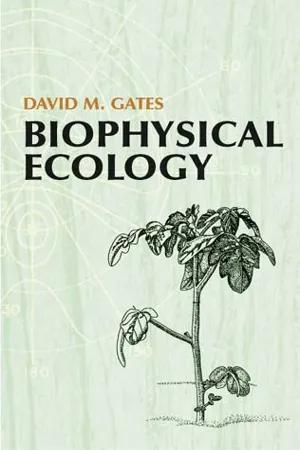Biological Sciences
Water Loss
Water loss refers to the process by which organisms release water from their bodies. This can occur through various means such as evaporation from the skin or respiratory surfaces, excretion, and sweating. In biological systems, maintaining water balance is crucial for proper physiological functioning, and excessive water loss can lead to dehydration and other health issues.
Written by Perlego with AI-assistance
Related key terms
6 Key excerpts on "Water Loss"
- eBook - ePub
- Neil Willey(Author)
- 2018(Publication Date)
- Garland Science(Publisher)
Chapter 4Water
The challenges of variable water supply overlap, in particular, with the challenges of CO2 acquisition and temperature variation.Key concepts
• Plant–water relations are important from a cellular to a global scale.• Human use of fresh water is dominated by irrigation of crops.• Water potential explains the movement of water in the soil–plant system.• Plants control resistance to flow to manage minor fluctuations in available water.• Physiological adjustments help plants to adapt to transient water deficit.• Roots are used to forage for water when it is in short supply.• Leaf adaptations help many plants to adapt to sustained dry conditions.• Xerophytes that inhabit chronically dry ecosystems adapt their stems, leaves, and life cycles.• Resurrection plants are the largest organisms that can survive complete desiccation.• A “blue revolution” in agriculture is probably necessary for global food security.Plant–water relations affect physiological processes from a cellular to a global scale
The ubiquity of water as the primary biochemical solvent reflects life’s origin in aqueous solutions, and enables the enhanced reaction rates that underpin life on Earth. Animals first evolved in the marine environment, and their sodium-requiring physiology means that, even in terrestrial ecosystems, they maintain a saline solution that bathes their cells. All terrestrial plants evolved from freshwater algae and therefore have to maintain simulated fresh water in and around their cells. However, fresh water is relatively scarce on the land surface. Terrestrial plant–water relations therefore exert significant control over the dynamics of unmanaged terrestrial ecosystems and the productivity of agricultural ecosystems.In addition to being a solvent, water acts as a matrix—that is, it provides a semi-structured environment—for life. The structures and properties of water under the conditions on Earth are unusual (Box 4.1 ). The hydrogen bonds that water molecules can form, and the supramolecular structures that arise from them, are vital to many reactions in plant physiology—for example, the structure and function of many enzymes are dependent on direct interactions with semi-structured water solutions. Water is also vital as a reagent in many hydrolysis/condensation and redox reactions in plants, and its high specific heat capacity means that evaporation of water requires much heat—hence transpiration can contribute significantly to heat loss. Plant cells have walls that generally inhibit their expansion, but water is drawn into their cells down solute concentration gradients, so plant cells mostly have positive hydrostatic pressures, as do many fungal cells— this is in contrast to most animal cells, which are under atmospheric pressure (Figure 4.1 ). The general terrestrial plant form, consisting of growing roots and shoots that bifurcate to provide a large surface area of interaction with the environment, is dependent on turgid cells because root and shoot growth is driven by hydrostatic pressure. Support for shoots in particular is also dependent on turgid cells. In addition, hydrostatic pressure controls stomatal aperture (Figure 4.2 - eBook - ePub
Environmental Plant Physiology
Botanical Strategies for a Climate Smart Planet
- Vir Singh(Author)
- 2020(Publication Date)
- CRC Press(Publisher)
4Water Relations
Water is the driving force of all nature.Leonardo da VinciTHE WATER PLANET AS HOME TO LIFE
Our Earth is a water planet. Water is not just a major component of the environment on Earth, but also a major component of all living organisms. The proportion of water on Earth and in living organisms is almost equal. This fact reveals that the phenomenon of life is uniform all over the planet as well as across all living organisms. Water is both an ingredient in anabolism as well as a product of catabolism. Water is central to the functioning of life because all the enzymes function only in an aquatic medium. Also, the role of water is vital in maintaining a thermal budget of the biosphere. The polarity of water makes it an excellent solvent.Despite having the largest share in the constitution of the living planet, the distribution of water on Earth is unequivocally uneven in terms of space, time, and type. Therefore, availability, acquisition, and conservation of water are important considerations, especially in the context of the organisms in desert, air, and semiarid environments.All organisms conserve an optimum amount of water in their body structures, so that all life processes continue to operate, keeping the organisms active and functional. Water Loss from the body is compensated with water intake by organisms. Organisms also live in aquatic environments where there could be a danger of water flooding into their bodies. But it does not take place, and the aquatic organisms maintain their water balance. Yet there are organisms that live in environments with high salinity, and they are successful in preventing saline water from flooding their bodies. Most of the organisms would expend energy in order to maintain their water balance in their environment. How the organisms maintain water balance is a subject of their water relations. An understanding of water relations is interesting to understand how the organisms are adapted to different environments characterized by water scarcity, water excess, and water type as well as how the water mediates life processes among organisms. - No longer available |Learn more
- Jose Perez-Castineira(Author)
- 2020(Publication Date)
- De Gruyter(Publisher)
8 ].Table 2.1: Water balance in sedentary adults living in temperate climate.Water inputs (milliliters/day) Water outputs (milliliters/day) Beverages 1,575a >1,000b Respiration & sweat 750a 900b Foods 675a 1,000b Feces 100a 200b Metabolic water 300a 400b Urine 1,600a 600–2,400b Total 2,550a 2,400b Total 2,550a 1,700–3,500 Data taken from references [3 ]a and [10 ]b .At the molecular level, water is transported across biological membranes by three different mechanisms: (1) by diffusion through the lipid matrix; (2) through some membrane-embedded channels or solute transporters; and (3) through specific water channels known as aquaporins. A common feature to these mechanisms is that water movement is driven by gradients of its own chemical potential [11 , 12 ]. The chemical potential of water in our bodies is essentially determined by the concentration of solutes or electrolytes in the biological fluids, usually measured as the number of moles of osmotically active species (osmoles) per kilogram of water (“osmolality”) or per liter of solution (“osmolarity”). Osmolarity and osmolality values do not differ much in dilute solutions, therefore, they are often used interchangeably [3 ]. The most important contributors to osmolarity in the body fluids are electrolytes like sodium (Na+ ), chloride (Cl- ), potassium (K+ ), calcium (Ca2+ ), magnesium (Mg2+ ), sulfate (SO4 2− ), or phosphate (PO4 3− ) and solutes such as glucose or urea [13 , 14 - eBook - ePub
- David M. Gates(Author)
- 2012(Publication Date)
- Dover Publications(Publisher)
2. The role of water in the energy budgets of plants is highly significant. Nearly all animal cells and tissues are permeable to water, and evaporation of water from animal surfaces is important in determining surface temperatures. Loss of water from a plant or animal has considerable effect on the osmotic potential of cells and concentrations of solutes within cells.The properties of water which relate to the evaporation and transpiration of water from plant and animal surfaces, as well as from bodies of liquid water, are described in this chapter.Latent Heat
The quantity of heat necessary to produce a change of state from solid to liquid is called the latent heat of fusion, and that quantity necessary to produce a change from liquid to vapor is the latent heat of vaporization. The latent heat of fusion of water is about 3.33 × 105 J kg–1 at 0°C. The latent heat of vaporization of water is 2.260 × 106 J kg–1 at 100°C, 2.356 × 106 J kg–1 at 60°C, 2.406 × 106 J kg–1 at 40°C, 2.454 × 106 J kg–1 at 20°C, and 2.501 × 106 J kg–1 at 0°C. The value often used for biological purposes is 2.427 × 106 J kg–1 at 30°C since many organisms exist at about this temperature much of the time. The error involved with using 2.427 × 106 J kg–1 is only 2:5% at 40°C and 2.0% at 10°C, so for many purposes it is scarcely necessary to put in a temperature function.Ideal Gas Law
Water vapor may be treated, to a first approximation, as an ideal gas, provided condensation is not taking place. An ideal gas of n moles at pressure p and temperature T occupying a volume V obeys the law(10.1)where R is the gas constant. It is known that 1 mole (the mass in grams, equal to the molecular weight) of any ideal gas occupies 22.4 × 10–3 m3 at 0°C and a pressure of 1 atm (101 N m–2 - eBook - ePub
Nutritional Biochemistry
From the Classroom to the Research Bench
- Sami Dridi(Author)
- 2022(Publication Date)
- Bentham Science Publishers(Publisher)
Body Fluid Homeostasis and Water Intake Regulation Sami DridiAbstract
Water is essential for life and a major key for survival. It is originated mostly from drinking, feedstuffs, and metabolic pathways (metabolic water). Water comprises from 75% body weight in infants to 55% in the elderly and is essential for cellular homeostasis. Thirst and water consumption are centrally and peripherally regulated by complex and tightly interconnected mechanisms. This chapter summarizes current progress and knowledge associated with body fluid homeostasis and the regulation of water intake at the central and peripheral levels.Keywords: Central circuit, ncRNA, Osomoregulation, Peripheral pathways, RAAS, Thirst, TRPV, Water intake.Introduction
As I stated in Chapter 1, we drink because we are thirsty. Water is the most abundant constituent (50-60% of body weight) in the body. Approximately 55-75% of total body water is in the intracellular compartment, and the rest (~25-45%) in the extracellular compartment with a ratio of 1:3 intravascular (plasma) and extravascular (interstitial) spaces. Animals and humans continuously lose water by various physiological and cellular processes, including sweating, urination, and basal metabolic activity. To maintain water homeostasis and compensate for such losses, animals must drink sufficient water and ingest food from external sources. The maintenance of this in-and-out water balance represents a key homeostatic function for survival in all organisms. It specifically occurs through a balance between water intake/excretion and salt intake/excretion to keep the osmolality of the extracellular fluid at the optimal set-point. These processes are finely and tightly controlled at the entire organism level, including the peripheral sensory system and the central neural circuits. This chapter highlights recent advances in the field and describes the molecular mechanisms involved in the regulation of body fluid homeostasis.6.1. Organs Involved in Osmoregulation
- eBook - ePub
- Tonks Fawcett, Roger Watson(Authors)
- 2014(Publication Date)
- Routledge(Publisher)
Chapter 2Fluid balance
Aim
To gain an understanding of the importance of water in the body.Learning outcomes
This chapter will enable the reader to:• understand the nature of water;• describe and explain the principles of diffusion and osmosis;• explain transport mechanisms across membranes;• understand and describe oedema and lymphoedema;• recognise the importance of documenting all fluid gains and losses in patients whose fluid homeostasis is disturbed.Introduction
The main fluid in the body is water and the importance of water in the body can be realised if we consider that 70 per cent of the body is composed of water. Water is found inside cells and outside cells in the plasma and in the fluid between cells, the interstitial fluid. Water is described as the universal solvent because a large variety of substances dissolve in it and this is a large part of the function of water in the body. For example, the blood carries a wide range of substances dissolved in the plasma from simple ionic compounds such as electrolytes to relatively complex molecules such as hormones.Water bathes every cell and tissue and organ of the body and the cells of the body are dependent upon their water content to maintain structure and function. The water surrounding the cells and tissues serves several functions such as providing protection in the brain, giving form and support to body structures such as the eye, bringing nutrients to the cell and removing waste products. Water also plays a part in control of the cells and tissues where it acts as a medium for chemical messengers such as hormones and neurotransmitters. It can be seen, therefore, that any disturbance to water homeostasis, or fluid balance, can have potentially very serious consequences for all the organs and systems of the body.What is water?
Body water is distributed between two major compartments, the intracellular fluid (ICF) and the extracellular fluid (ECF). The ICF comprises about 50 per cent of body water and the ECF is comprised of the watery component of the blood, the plasma and the water that is found between cells, the interstitial fluid. The nature of the fluid compartments of the body and exchanges between them are largely determined by the nature of water; therefore, the physical chemistry of water will be briefly considered before moving on to the physiological aspects of fluid balance.
Index pages curate the most relevant extracts from our library of academic textbooks. They’ve been created using an in-house natural language model (NLM), each adding context and meaning to key research topics.





